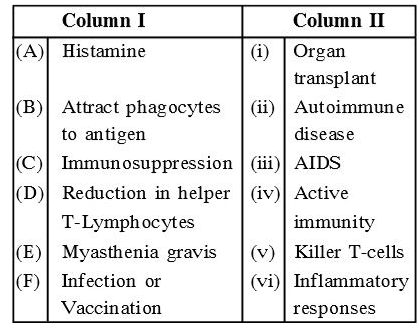A basic communication system consists of:
(1)transmitter(2)information source(3)user of information(4)channel(5)receiver
12345
21453
24135
25143
The correct Answer is:B
To solve the question regarding the basic communication system, we need to identify the correct sequence of components involved in the communication process. Here’s a step-by-step breakdown:
Step 1: Identify the Components
The basic communication system consists of five main components:
1. Information Source
2. Transmitter
3. Channel
4. Receiver
5. User of Information
Step 2: Determine the Sequence
To understand how these components interact, we need to arrange them in the order they function in a communication system:
1. Information Source (2): This is where the information originates. Without an information source, there would be nothing to transmit.
2. Transmitter (1): The transmitter takes the information from the source and converts it into a signal suitable for transmission.
3. Channel (4): The channel is the medium through which the signal travels. It can be air, fiber optics, etc.
4. Receiver (5): The receiver captures the signal from the channel and converts it back into a form that can be understood.
5. User of Information (3): Finally, the user of information is the end recipient who interprets or uses the information.
Step 3: Final Arrangement
Based on the above reasoning, the correct order of components in a basic communication system is:
- Information Source (2)
- Transmitter (1)
- Channel (4)
- Receiver (5)
- User of Information (3)
Conclusion
Thus, the correct sequence is: 2, 1, 4, 5, 3.
Answer
The answer is option B: (2) Information Source, (1) Transmitter, (4) Channel, (5) Receiver, (3) User of Information.
---
The basic communication system consists of five main components:
1. Information Source
2. Transmitter
3. Channel
4. Receiver
5. User of Information
To understand how these components interact, we need to arrange them in the order they function in a communication system:
2. Transmitter (1): The transmitter takes the information from the source and converts it into a signal suitable for transmission.
Based on the above reasoning, the correct order of components in a basic communication system is:
- Information Source (2)
- Transmitter (1)
- Channel (4)
- Receiver (5)
- User of Information (3)
Thus, the correct sequence is: 2, 1, 4, 5, 3.
The answer is option B: (2) Information Source, (1) Transmitter, (4) Channel, (5) Receiver, (3) User of Information.
Topper's Solved these Questions
- BOOK - VMC MODULES ENGLISHCHAPTER - JEE MAIN REVISION TEST - 18EXERCISE - PHYSICS - SECTION 25videos
JEE MAIN REVISION TEST - 18
- BOOK - VMC MODULES ENGLISHCHAPTER - JEE MAIN REVISION TEST - 13EXERCISE - PHYSICS (SECTION 2)5videos
JEE MAIN REVISION TEST - 13
- BOOK - VMC MODULES ENGLISHCHAPTER - JEE MAIN REVISION TEST - 19EXERCISE - PHYSICS25videos
JEE MAIN REVISION TEST - 19
Similar Questions
A basic communication system consists of (A) transmitter (B) information source (C ) user of information (D)channel (E ) receiver
Choose the correct sequence in which these are arranged in a basic communicarion system.View SolutionDraw a block diagram of a generalized communication system. Write the functions of each of the following:
(a) Transmitter
(b) Channel
(c) Receiver .View Solution
Knowledge Check
- Question 1 - Select One
A basic communication system consists of (A) transmitter (B) information source (C ) user of information (D)channel (E ) receiver
Choose the correct sequence in which these are arranged in a basic communicarion system.AABCDEBBADECCBDACEDBEADC - Question 2 - Select One
In optical communication system operating at 1200nm, only 2% of the source frequency is available for TV t ransmission having a bandwidth of 5 MHz. the number of TV channels that can be transmitted is
A2 millionB10 millionC0.1 millionD1 million - Question 3 - Select One
Optical communication system having an operating wavelength λ metre can use only x % of its source frequency as its channel band width. The system is to be used for transmitting T.V signals requiring a band width of F hertz. How many channels can this system transmit simultaneously? Show graphically how this number of channels varies with operating wavelength of the system.
AλF/CxB2Cx/100λFCcx/50λFDcx/100λF
A: Transducer in communication system converts electrical singal into a physical quantity.
R: For information signal to be transmitted directly to long distances, modulation is not a necessary process.View SolutionA: Optical communication system is more economical than other system of communications.
R: The information carrying capacity of a communication system is directly proportional to its band width.View SolutionMatch the column I with column II.
 View Solution
View SolutionPerhaps, the most commonly used mode of communication involves use of free space as a communication channel between transmitter and receiver. The various possible modes of using of free space have been described below
Ground wave communication : This mode is used for low frequency as at high frequency, losses become large. This is useful for distance of the order of 1 km.
Space wave communication: The signals are transmitted directly from transmitter to receiver. There is no limit to upper frequency, but its range is limited to few hundred kilometers. The range depends on the height of transmitting antenna
Sky wave communication : The signals are sent towards sky They are reflected back towards earth by ionosphere. Its range can be above 500 km. But, very high frequencies (above 10 MHz) are not reflected back. Satellite communication: The signals that cannot be reflected back by ionosphere are reflected back by satellite. Moon is a passive satellite of earth.
The frequency range allotted to FM radio broadcast is 88 MHz to 108 MHz. Which of the following communication channels can be used for its transmission?
A. Sky wave communication only
B. Space wave communication only
C. Satellite communication only
D. Either space wave communication or satellite communicationView SolutionExamine the consistency of the system of equations
2x−y=5 x+y=4View Solution

